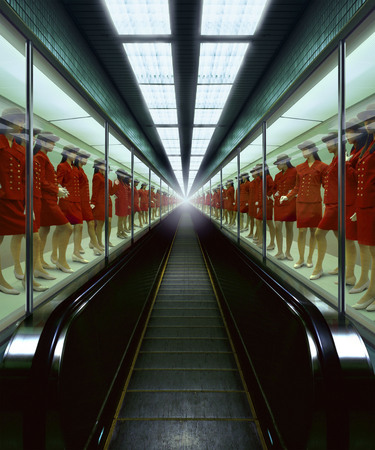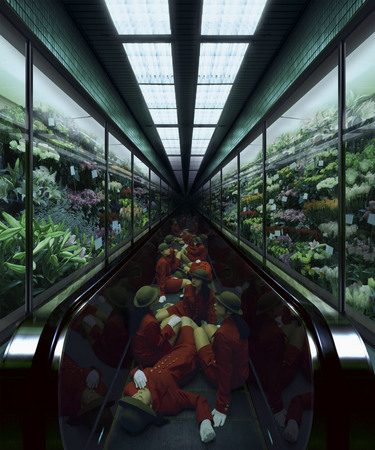Girls — lift attendants


Miva Yanagi. From “Girls – lift attendants” series. The collection of the author, Tokyo
Miva Yanagi. From “Girls – lift attendants” series. The collection of the author, Tokyo
Moscow, 18.03.2005—10.04.2005
exhibition is over
Moscow Museum of Modern Art
17 Ermolaevsky lane (
www.mmoma.ru
Share with friends
The collection of the author, Tokyo
For the press
In the early 1990s, I was living life between Paris and Osaka. Since I lived along the Hankyū railway line near Umeda station (Osaka), I often walked through the gorgeous passageways of the Hankyū shopping mall inside the station. Miwa Yanagi says that at around the same time, she also used to pass the Hankyū department store daily on her way to attain a teaching degree and earn a living, so we must have crossed paths at some point.
Department stores in France are called Grand Magasin. Starting with the opening of Bon Marche in Paris in 1852, department store culture flourished in modern cities such as New York, London, and Berlin. In Japan, they appeared fifty years later at the dawn of the 20th century, and in the Kansai region, residential areas, amusement parks as well as the Takarazuka entertainment theaters developed along the Hankyū line. Thus, department stores were strategically created as «terminals,» when the initial systems of transport were being made to link life, culture and pleasure.
Once a liberating base for modernism, department stores were at the same time placed in densely populated cities, and the expansion and diversification of commercial spaces contributed to an increasing sense of alienation and obsolescence. What Yanagi pays attention to are the cultural codes embedded within the great architecture and passageways (arcades) that have frozen the atmosphere of modernism amidst the acceleration of the period; the Elevator Girls, like apparitions, appear as its peculiar signs. This fabricated space of modernism, stripped of a time axis, is simultaneously akin to a future city where all excitement has faded. Yanagi’s Elevator Girls reside in both a past and future time-space.
In the West, we often see male elevator attendants (elevator boys) to relieve the danger that strangers sense in tightly enclosed spaces. The Elevator Girls and female guides in Japan, who are beautifully made like mannequins, outfitted in clean uniforms and hats, and who lack human qualities, exist as fascinating curiosities for foreign visitors. Stripped of individuality, their homogenously trademarked appearance and attitude that consumer culture has given birth to have made them akin to cyborgs. The coded services that the girls conduct flawlessly to others reflect a contemporary version of the much-admired geisha. Perhaps one of the reasons sharp-sighted curators abroad have quickly taken up the Elevator Girls theme of Yanagi’s photographic series is due to this exotic element. In addition, they are copied like commodities, and within the multiplication of this attractive apparatus is a type of horror that evokes the release of a virtual creature and extraction of a post-human sense of reality. In dire taste, we are enclosed by but unable to touch this anesthetized eroticism. Through Yanagi’s vision, the crowded, busy city of Osaka, which was a stage set for «Blade Runner,» is transformed into a virtual daydream where magnificent figures of women bloom in profusion.
In the early Elevator Girls series, the artist displays a natural taste for Japan that one could say is due to her innate sensibility as a Kobe native and Kyoto city resident. However, in Yanagi’s case, she also offers a radical criticism that coolly objectifies a sense of exoticism. This criticism is close to the vision and photographic work of Osaka-born Yasumasa Morimura. For example, Yanagi renders the architectural spaces of cultural institutions such as Japan’s natural history museums and art museums, including botanical gardens and zoos, as manifestations, similar to department store culture, of an artificial modernism that constantly references the West. Unlike Morimura’s method of inserting his own body into canonized works of Western art and confronting each work one by one, Yanagi concentrates on the actual spaces that continuously preserve the fabricated production of modernism. Within this process, the fictional Elevator Girls, bred by purified manuals, become a metaphor for Japanese art and culture.
When female students from two-year colleges work in the customer service industry, they suddenly change their appearance and personality in order to appear favorable to others. Yanagi would continue to watch this process with surprise and frustration. These girls possess neither a feminist resistance nor are conscious of their victimization; they are forcefully molded into particular forms of speech as they happily comply toward others’ gazes; they transform into beautiful «things» (commodities). This seems largely due to the artificial sense of beauty that Japan has generated and derived from the country’s long-standing will to live up to the model West. Like a shadow, this historically unconscious state lies hidden in Yanagi’s Elevator Girls.
The Elevator Girls are maidens oblivious of their own transformations into beautiful «things.» Yanagi entrusts their narrow-minded, fragile self-pleasures and illusions into greenhouse flowers and tropical fish in aquariums. Isolated and maintained by artificial light, they express the death of these glass gardens. Lying within the almost melting poses of these Elevator Girls and female attendants is a sexuality that waits to be eaten like a sweet candy.
The kaleidoscopic stage of Yanagi’s «Frozen Utopia» is akin to places such as an overly elaborate decorative space, a clean and unpopular hotel lobby or a natural history museum, where we may find items such as a royal chandelier, a stone architectural relief, or a delicate metal ornament. Rather than an environment made for people, they are non-existent places that continue to complete and replicate themselves. The Elevator Girls, who stand upon the apparatus of a mirror surface that continues to transform into a non-cohesive panorama, may also be clones born out of the alienation of the great city.
Aomi Okabe (from «White Casket» Nazraeli Press. 2004)


